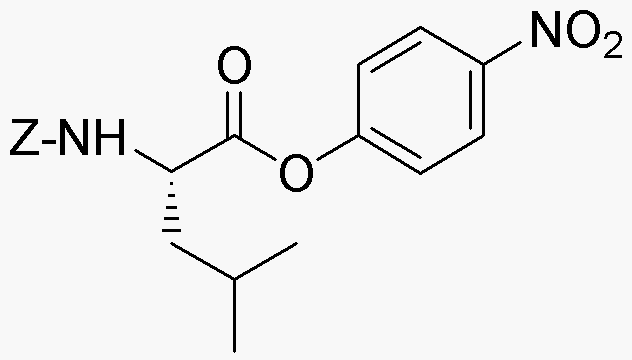Z-L-leucine 4-nitrophenyl ester is widely utilized in research focused on:
- Peptide Synthesis: This compound serves as a valuable building block in the synthesis of peptides, enhancing the efficiency of coupling reactions and improving yield.
- Drug Development: It is used in the design of prodrugs, which can improve the bioavailability of therapeutic agents, making them more effective in treating various conditions.
- Biochemical Research: Researchers employ this ester in studies related to protein interactions and enzyme activity, providing insights into cellular processes and potential therapeutic targets.
- Analytical Chemistry: It acts as a standard in chromatographic techniques, helping to calibrate instruments and ensure accurate measurements in complex mixtures.
- Food Industry: The compound can be explored in flavor enhancement applications, where its properties may contribute to the development of novel food additives.
General Information
Properties
Safety and Regulations
Applications
Z-L-leucine 4-nitrophenyl ester is widely utilized in research focused on:
- Peptide Synthesis: This compound serves as a valuable building block in the synthesis of peptides, enhancing the efficiency of coupling reactions and improving yield.
- Drug Development: It is used in the design of prodrugs, which can improve the bioavailability of therapeutic agents, making them more effective in treating various conditions.
- Biochemical Research: Researchers employ this ester in studies related to protein interactions and enzyme activity, providing insights into cellular processes and potential therapeutic targets.
- Analytical Chemistry: It acts as a standard in chromatographic techniques, helping to calibrate instruments and ensure accurate measurements in complex mixtures.
- Food Industry: The compound can be explored in flavor enhancement applications, where its properties may contribute to the development of novel food additives.
Documents
Safety Data Sheets (SDS)
The SDS provides comprehensive safety information on handling, storage, and disposal of the product.
Product Specification (PS)
The PS provides a comprehensive breakdown of the product’s properties, including chemical composition, physical state, purity, and storage requirements. It also details acceptable quality ranges and the product's intended applications.
Certificates of Analysis (COA)
Search for Certificates of Analysis (COA) by entering the products Lot Number. Lot and Batch Numbers can be found on a product’s label following the words ‘Lot’ or ‘Batch’.
*Catalog Number
*Lot Number
Certificates Of Origin (COO)
This COO confirms the country where the product was manufactured, and also details the materials and components used in it and whether it is derived from natural, synthetic, or other specific sources. This certificate may be required for customs, trade, and regulatory compliance.
*Catalog Number
*Lot Number
Safety Data Sheets (SDS)
The SDS provides comprehensive safety information on handling, storage, and disposal of the product.
DownloadProduct Specification (PS)
The PS provides a comprehensive breakdown of the product’s properties, including chemical composition, physical state, purity, and storage requirements. It also details acceptable quality ranges and the product's intended applications.
DownloadCertificates of Analysis (COA)
Search for Certificates of Analysis (COA) by entering the products Lot Number. Lot and Batch Numbers can be found on a product’s label following the words ‘Lot’ or ‘Batch’.
*Catalog Number
*Lot Number
Certificates Of Origin (COO)
This COO confirms the country where the product was manufactured, and also details the materials and components used in it and whether it is derived from natural, synthetic, or other specific sources. This certificate may be required for customs, trade, and regulatory compliance.


